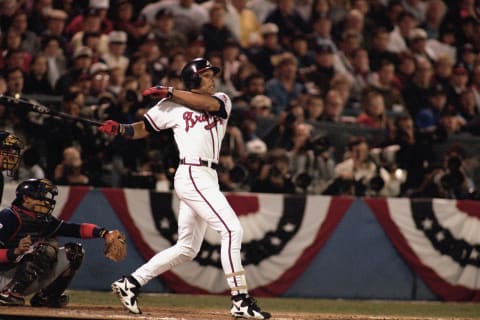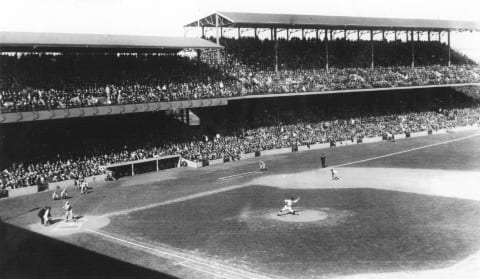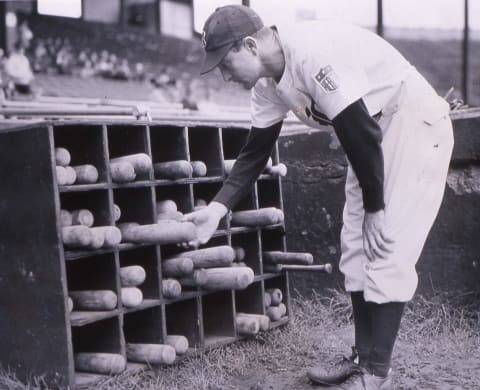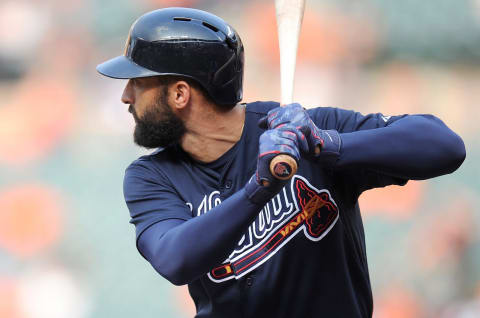Atlanta Braves Franchise top-ten outfielders: Tommy Holmes


The countdown of the top ten outfielders in Atlanta Braves Franchise history reaches the final five today. Today’s player was a 5′ -10″ Irishman from Brooklyn who shattered a 23-year old MLB record.
The list of Atlanta Braves franchise outfielders so far includes:
- Number 10 – Sid Gordon
- Number 9 – Rico Carty
- Number 8 – Billy Hamilton
- Number 7 – David Justice
- Number 6 – Hugh Duffy
Tommy Holmes joins that list at number five.
Tommy Holmes SABR bio is the source for quotes and backstory unless otherwise linked. It also appears in “Spahn, Sain, and Teddy Ballgame: Boston’s (almost) Perfect Baseball Summer of 1948.”
If asked to name a Boston Braves’ fan’s favorite player from the 1940s, you might choose Warren Spahn or Johnny Sain, but the right answer is Tommy Holmes.
Holmes, became an immediate fan favorite after moving from the Yankees to the Braves in 1942. His SABR biography summed it up like this.
. . . from 1942 to 1952, nobody enjoyed the type of unabashed love he received from the denizens of the 1,500-seat, stand-alone bleachers situated behind his right-field playing spot. Dubbed the Jury Box by a sportswriter who once counted just 12 fans seated there in leaner times.
While with Boston, he gave them plenty to cheer about.
His friends called him Kelly, a nickname that stayed with him throughout his career. He wanted a career as a boxer like his dad, but dad quickly put the kibosh on that, so Tommy Holmes focused on baseball.
His senior year in high school, he hit .613 after coach Anthony Tarrantino took him under his wing. Tarrantino had Holmes eat his lunch in the gym during the winter, while the coach taught him the strike zone, turning on inside pitches, and hitting to the opposite field.
When the weather warmed up, Holmes played ball on Sundays at one of the 21 diamonds at the Parade Grounds. After graduation, he played for the Brooklyn Bushwicks and lined-up against a barnstorming team from the Negro Leagues, led by Josh Gibson and Satchel Paige. Holmes didn’t know until later who pitched but remembered he got a couple of hits.
A Yankee scout saw him play with the Bushwicks and signed him. Holmes reported to spring training with the Yankees in 1937 and made it to AAA in 1940. After two seasons batting over .300, he was ready for the big leagues, but the Yankee outfield featured Joe DiMaggio, Tommy Henrich, and Charlie “King Kong” Keller.
Yankee Skipper Joe McGraw promised Holmes that if he had no place for him, he would try to move him to a club that did. On December 9, 1941, the Yankees kept their word sending Holmes to the Braves for two PTBNL; neither player made an impact in the Bronx.

Boston is home for Holmes
Holmes began his career for the Braves in 1942, playing centerfield and wearing the number one jersey for manager Casey Stengel. In rightfield was future Hall of Fame outfielder Paul Waner, who became his mentor and hitting coach.
Waner – ‘Big Poison’ – was 39 and well past prime, but he was also a career .339/.405/.484/.899 batter with three batting titles and an NL MVP under his belt. After Holmes went 0-9 in a twin bill, Waner told him not to worry, just turn up early in the morning, and he’d fix that. Holmes turned up and said it changed his career.
This was the beginning of my hitting life. I was a line-drive hitter, same as Paul. (Waner told him), ‘See that foul line over there? I’m going to show you how to hit it. Never hit the ball where three guys can catch it, not with that wind blowing in at Braves Field. Shoot for the foul lines. If a few go out of play, don’t worry about it. You don’t pay for the balls.’”
In 2015, Seamheads expanded on the quote above.
. . .If they tried to cover the lines on him, then they were opening gaps in right- and left-center and (Waner) would put the ball out there.This is what he taught me. And while I wasn’t a power hitter, I used to get around 35 or forty doubles a year, from following Paul’s advice.”
Under Waner’s wing, Holmes finished tied tenth in the league with 155 hits from the leadoff spot, and coach Tarrantino’s instruction on the strike zone helped him walk 64 times while striking out only 10.
Poison becomes production
Holmes’ average slipped to .270 in 1943, a career-low for full-season play, and he got on base at a .334 clip, another career low. However, he racked up 170 hits, including 33 doubles and ten triples, walked 58 times, struck out a career-high 20 times, and finished #29 in MVP balloting.
In the off-season, Holmes worked in the Brooklyn shipyards to support the war effort and make money; Braves players didn’t earn much, and he had a family to feed.
He reported to spring training in 1944, stronger than ever. With the season less than a month away, Holmes received a notice to report for his draft physical. Fortunately for the Braves, doctors determined a chronic sinus condition made him unfit for duty in Europe, and he returned to baseball.
The added muscle turned into a batting line of .309/.372/.456/.828 – #9/#12/#11/#12 in the league respectively – with a 128 OPS+. He also:
- delivered 195 hits, third in the league behind Phil Cavarretta and Stan Musial,
- 47 doubles, third in the league behind Stan Musial and Augie Galan, and
- 13 home runs, tied for ninth in the league.
- finished #23 in NL MVP voting
It was Holmes’ first year with double-digits in homers, and he continued to make pitchers throw strikes, walking 61 times and striking out only 11.

The Summer of 45
The Braves moved Holmes to right-field in 1945, putting him right in front of his fans in The Jury Box. Before every game, his fans yelled out, “How many hits today Tommy,” and he’d hold up his fingers in reply. No one kept track of his accuracy, but in 1945, he was rarely off by more than one.
Holmes started the season with a 15 game hitting streak that ran from opening day on April 17, through the third game of a series against the Giants at the Polo Grounds on May 6.
During this streak, Holmes went 25-63, batted .385/.444/.585/1.029, and walked seven times without striking out; and that was just the beginning.
On June 6 and June 7 the Braves played back-to-back doubleheaders against the Phillies – yes, four games in two days. The Braves won all four, and Holmes went 10 for 21; he would go on to hit in the next 34 games; a 37 game hitting streak that lasted 33 days, including nine additional doubleheaders and totaled 344 innings, shattering Rogers Hornsby’s record of 33 games set in 1922.
During the big streak, Holmes went 66-156, including ten doubles, three triples, and nine home runs. He walked 18 times, struck out twice, batted 423/.494/.699/1.193, and drove in 43 runs while scoring 42. The Braves won 22 games, and Holmes wasn’t done.
Holmes began another hitting streak lasting 12 games from August 12 through August 19. He batted .396/.429/.849.1.278 and hit six homers in that streak, and he ended the season with a nine-game streak from September 18 to September 30, batting .385/.429/.462/.890.
1945 by the numbers
Holmes’ longest hitless streak – four games – lasted from July 21 through July 24. Altogether in 1945 Holmes had:
- one five-hit game
- three four-hit games
- 18 three-hit games
- 48 two-hit games
- and 57 one-hit games
He went hitless just 27 times; his monthly splits are eye-watering
| G | PA | AB | R | H | 2B | 3B | HR | RBI | BB | SO | BA | OBP | SLG | OPS | |
| April/March 11 | 54 | 47 | 10 | 20 | 4 | 1 | 0 | 7 | 7 | 0 | .426 | .500 | .553 | 1.053 | |
| May 23 | 110 | 100 | 22 | 38 | 9 | 1 | 4 | 21 | 9 | 1 | .380 | .431 | .610 | 1.041 | |
| June 29 | 141 | 118 | 30 | 46 | 5 | 3 | 5 | 28 | 17 | 2 | .390 | .482 | .610 | 1.092 | |
| July | 33 | 150 | 130 | 27 | 42 | 13 | 0 | 8 | 24 | 20 | 2 | .323 | .413 | .608 | 1.021 |
| August 29 | 130 | 122 | 22 | 43 | 10 | 1 | 9 | 23 | 8 | 1 | .352 | .392 | .672 | 1.064 | |
| Sept/October 29 | 129 | 119 | 14 | 35 | 6 | 0 | 2 | 13 | 9 | 3 | .294 | .349 | .395 | .744 |
Holmes batted .348/.421/.557/.978 with 17 homers against RHP, but lefties weren’t a problem for Holmes. He batted .321/.380/.548/.928 and with eight homers against same-sided pitching in 1945 and broke Hornsby’s record on July 7, 1945, with a double off left-hander Preacher Roe.
When the season ended, Holmes led the league with 245 hits, 47 doubles, and 28 homers.
He walked 70 times, struck out nine, the first man ever to lead the majors in most homers and fewest strikeouts in the same season, batted .352/.420/.577/.997, with a 175 OPS+ and 367 total bases.
Holmes 117 RBI came second to Dixie Walker’s 124, and his .352 average was second in the NL: Cavarretta edged him out on the last day of the season to win the batting title. Average was the only stat where Cavarretta led Holmes, but the Braves finished 67-85, and the Cubs won the NL Pennant; the pennant was enough to make Cavarretta the NL MVP instead of Holmes.
Baseball-Reference makes that and 8.3 rWAR season and Fangraphs says it was worth 8.7 fWAR good for second in MLB, and an MLB best .463 wOBA and 171 wRC+

Finishing touches
Holmes never approached his 1945 numbers again, but much like Atlanta Braves Nick Markakis, he remained a prolific hitter and a hard man to strike out, though his home run production returned to single digits.
His 1946 season brought saw him deliver 175 hits, post a .801 OPS (126 OPS+), strikeout 14 times, walk 56, and earn finish #19 in MVP voting. In 1947, Holmes once more led the league in hits with 191, walked 44 times and struck out 16, and batted .309/.360/.418/.776.
The Braves World Series season of 1948 brought Tommy back to life. Long before anyone knew what to call it, Tommy Holmes had a walk-up song. The fans loved Holmes, and he loved them back, A band called The Three Troubadours were fans, began playing “Has Anybody Here Seen Kelly?” whenever Holmes came to the plate.
Either the music (I listened to it so that’s unlikely), pennant race fever or one last hurrah nudged Holmes enough that he began hitting like his old self. He once again provided 190 hits, walked 46 times, struck out a shocking (for him) 20 times, while batting .325/.375/.439/.814; good for another 3.8 fWAR season. He didn’t hit well in the World Series but did manage to ruin Bob Feller’s day by driving in a run giving the Braves a 1-0 lead in the series and Feller a loss even though he allowed only two hits.
Holmes hit was the high point of the series for the Braves. They lost four of the next five with Holmes making the final out of game six. Adding insult to injury, the next day, he had to have an emergency appendectomy.
After the games
The Braves released Holmes in 1950 but offered him a job as manager for the Braves minor league team in Hartford. Halfway through the season, they ask him to manage the Braves, but a year later, they fired him and hired Charlie Grimm. He was magnanimous at the time but later admitted being fired hurt.
(Holmes told) Boston Herald in 1986: “It broke my heart when they let me go. I was ready to have a home built up there. That was going to be my home. It was a shock. It was like losing your family. I don’t think I ever got over that even yet.”
After a brief visit with the Dodgers, Holmes managed in the minors until 1959 when he took over as director of the New York Journal-American’s sandlot baseball program- later renamed the New York Sandlot Baseball Alliance. Coincidentally, a job his old friend and mentor Paul Waner once held, where he successfully taught the game to thousands of kids from low-income families.
In 1973 he became director of amateur baseball relations for the New York Mets and was at Shea Stadium on July 25, 1978, when Pete Rose broke his record, seven days later the Atlanta Braves ended Rose’s streak at 44 games. The pair pictured together in this photo.
Tommy Holmes died April 14, 2008, 66-years to the day from his first Major League game. He was 91 years old.
That’s a wrap
In many ways, Holmes and current Atlanta Braves veteran presence Nick Markakis are alike. Both steadily provided hits and OBP, but neither hit for a lot of power. There’s no image of Holmes in our library, but this link shows Holmes with Bob Elliot and Warren Spahn after World Series game five in 1948.
Holmes never struck out more than 20 times a season and became one of four players (Ernie Lombardi, Lefty O’Doul, and Ted Williams) who hit more homers than he had strikeouts in four seasons. In his career, he struck out 122 times in 4,992 at-bats, second behind Hall of Fame second baseman Joe Sewell among four players with at least 4500 at-bats and less than 125 strikeouts.
Like Markakis, Holmes was by every account I can find, a genuinely good guy. His children told of how he would leave the ballpark after a game, see kids playing in a sandlot, and stop to play the game with them. It wouldn’t surprise me if Nick does that as well.
Next. Joey gets the unkindest cut for a pitcher. dark
He’s number five on my list, but Saul Wisnia summed Holmes up well.
Tommy Holmes — No. 1 in your (old) scorebook, and No. 1 in the hearts of Boston Braves fans.
.